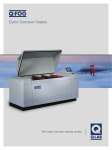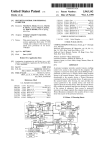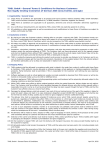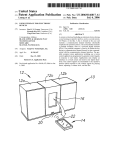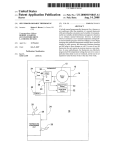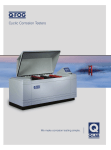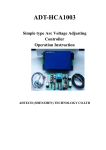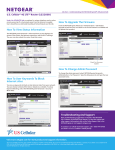Download System and method for automatically programming hvac system
Transcript
US 20120290138A1 (19) United States (12) Patent Application Publication (10) Pub. No.: US 2012/0290138 A1 DiFulgentiz (43) Pub. Date: Nov. 15, 2012 (54) SYSTEM AND METHOD FOR AUTOMATICALLY PROGRAMMING HVAC SYSTEM TEMPERATURE ADJUSTMENT Publication Classi?cation (51) Int Cl G05D 23/19 (200601) TIMES (52) (75) Inventor: (Us) (73) Assignee: (21) Appl. No.: (22) Filed: US. Cl. ...................................................... .. 700/278 Robert A. DiFulgentiz, Frisco, TX (57) ABSTRACT A programmable HVAC controller, a method of automati LennoX Industries, Inc., Richardson, TX (US) cally programming HVAC system temperature adjustment times and an HVAC system incorporating the system or the method. In one embodiment, the programmable HVAC con troller includes: (1) a memory subsystem, (2) a communica 13/302,999 tion subsystem con?gured to receive a Wake-up alarm time and (3) a processing subsystem coupled to the memory and communication subsystems and con?gured to: (3a) set a “sleep” temperature adjustment time based on a time the Wake-up alarm time is received and (3b) set a “Wake” tem perature adjustment time based on the Wake-up alarm time. Nov. 22, 2011 Related US. Application Data (60) Provisional application No. 61/484,918, ?led on May 11,2011. 21° 220 \ SET WAKE-UP ALARM ON WIRELESS DEVICE I 230 \ RECEIVE WAKE-UP ALARM TIME INTO PROGRAMMABLE CONTROLLER I SET "SLEEP" TEMPERATURE 240 \ ADJUSTMENT TIME BASED ON TIME WAKE-UP ALARM TIME IS RECEIVED I 250 / RUN "SLEEP" PROGRAM I 260 / SET "WAKE" TEMPERATURE ADJUSTMENT TIME BASED ON WAKE-UP ALARM TIME I 270 / RUN "WAKE" PROGRAM 280 Patent Application Publication Nov. 15, 2012 US 2012/0290138 A1 100 FIG- 1 PROGRAMMABLE HVAC CONTROLLER : 160 \ OTHER HVAC : : EQUIPMENT PROCESSOR : / 120 MEMORY / 130 SUBSYSTEM SUBSYSTEM / 150 = SENSOR I I wIRELEss DEVICE 180/ 190 / SCREEN 4,’ COAIZVJLIJENLIE?ION SUBSYSTEM \ USER "70 FIG. 2 21° @ 220 \ SET WAKE-UP ALARM ON WIRELESS DEVICE 230 \ RECEIVE WAKE-UP ALARM TIME INTO PROGRAMMABLE CONTROLLER SET "SLEEP" TEMPERATURE 240 \ ADJUSTMENT TIME BASED ON TIME WAKE-UP ALARM TIME IS RECEIVED I 250 _/ RUN "SLEEP" PROGRAM I 260 _/ SET l'WAKE" TEMPERATURE ADJUSTMENT TIME BASED ON WAKE-UP ALARM TIME I 270 _/ RUN 'WAKE PROGRAM 280@ INTERFACE \ "10 Nov. 15, 2012 US 2012/0290138 A1 SYSTEM AND METHOD FOR AUTOMATICALLY PROGRAMMING HVAC SYSTEM TEMPERATURE ADJUSTMENT TIMES “sleep” temperature adjustment time based on a time the Wake-up alarm time is received and (3b) set a “Wake” tem perature adjustment time based on the Wake-up alarm time. [0006] Another aspect provides a method of automatically programming HVAC system temperature adjustment times. CROSS-REFERENCE TO RELATED APPLICATION [0001] This application claims the bene?t of US. Provi sional Application Ser. No. 61/484,918, ?led by DiFulgentiZ on May 11, 2011, entitled “Scheduling Integration With Smartphone or Tablet Alarm,” commonly assigned With this application and incorporated herein by reference. In one embodiment, the method includes: (1) receiving a Wake-up alarm time into a programmable controller, (2) set ting a “sleep” temperature adjustment time in a program mable HVAC controller based on a time the Wake-up alarm time is received and (3) setting a “Wake” temperature adjust ment time in a programmable HVAC controller based on the Wake-up alarm time. [0007] Yet another aspect provides an HVAC system. In TECHNICAL FIELD one embodiment, the HVAC system includes: (1) a program [0002] This application is directed, in general, to heating, ventilation and air conditioning (HVAC) systems and, more mable HVAC controller and (2) other HVAC equipment coupled to the programmable HVAC controller. The pro grammable HVAC controller includes: (1a) a memory sub system, (lb) a Wireless communication subsystem con?gured speci?cally, to a system and method for automatically pro gramming HVAC system temperature adjustment times. BACKGROUND [0003] A programmable HVAC controller (Which may or may not include all of the features of a thermostat) is designed to adjust the temperature according to a series of programmed settings (sometimes called “setbacks”) that take effect at dif ferent times of the day. In recent years, programmable HVAC controllers have become increasingly popular, as their use may result in energy savings of up to 30%. To achieve this performance, programmable HVAC controllers reduce the amount of heating/cooling provided by the heating, ventilat ing and air conditioning (HVAC) system responsible for con ditioning the air Within a space at propitious times. For example, during the cooling season, a programmable HVAC controller used in a home may be programmed to alloW the temperature in the house to rise during the Workday When no one is home but begin cooling the house before the occupants arrive, thereby alloWing the house to be cooled doWn to the appropriate temperature setting upon the arrival of the occu pants While saving energy during peak outdoor temperatures Without sacri?cing the occupants’ comfort. Conversely, dur ing the heating season, the programmable HVAC controller may be programmed to alloW the temperature in the house to drop When the house is unoccupied during the day and also at night after all occupants have gone to bed and re-heating the house prior to the occupants arriving home in the evening or Waking up in the morning. [0004] A basic programmable HVAC controller imple ments a single program With tWo periods of time (a Warmer period and a cooler period) that run every day. More sophis ticated programmable HVAC controllers alloW four (or more) Warm and/or cool periods, commonly referred to as “Wake,” “leave,” “retum” and “sleep” times, to be set each day, each of Which may be set to a unique temperature. Today, most pro gramming of settings is done at a user interface of the con troller and With reference to a clock internal to the controller or the HVAC system as a Whole. SUMMARY [0005] One aspect provides a programmable HVAC con to receive a Wake-up alarm time Wirelessly and (1c) a pro cessing subsystem coupled to the memory and Wireless com munication subsystems and con?gured to set a “sleep” tem perature adjustment time based on a time the Wake-up alarm time is received and further set a “Wake” temperature adjust ment time based on the Wake-up alarm time. BRIEF DESCRIPTION [0008] Reference is noW made to the folloWing descriptions taken in conjunction With the accompanying draWings, in Which: [0009] FIG. 1 is a block diagram of one embodiment ofa programmable HVAC controller con?gured to accommodate a system for automatically programming HVAC system tem perature adjustment times; and [0010] FIG. 2 is a How diagram of one embodiment of a method of automatically programming HVAC system tem perature adjustment times. DETAILED DESCRIPTION [0011] It is realiZed herein that the conventional approach to programming HVAC settings described in the Background above suffers from a signi?cant disadvantage, namely that a person is required to make a separate and special effort to program settings using its dedicated, often Wall-mounted, user interface. [0012] Many people have come to rely on high-end cell phones, called “smartphones,” and personal digital assistants (PDA), such as tablets, to satisfy a need for information and order in their lives. Examples of modern, commercially avail able smartphones include the Apple iPhone®, the Motorola Droid® and Triumph®, the BlackBerry Torch® and Bold®, the Sharp FX Plus®, the Samsung Vitality® and Admire®, the HTC Wild?re® and Status® and the LG Thrill® and Genesis®. Examples of modern, commercially available tab lets include the Apple iPad®, the Sony Tablet S®, the Sam sung Galaxy Tab 10.10, the Toshiba Thrive®, the Acer Iconia Tab A500®, the Asus Eee Pad Transformer® and the Black Berry Playbook®. [0013] Enabled by their poWerful Wireless communication troller. In one embodiment, the programmable HVAC con capability, these relative neWcomers have made signi?cant troller includes: (1) a memory subsystem, (2) a communica tion subsystem con?gured to receive a Wake-up alarm time and (3) a processing subsystem coupled to the memory and communication subsystems and con?gured to: (3a) set a ances, such as desktop computers, telephones, stereos and televisions. Many have come to rely on smartphones and strides toWard replacing a host of previously ubiquitous appli tablets, carrying them throughout the day and using them as Nov. 15, 2012 US 2012/0290138 A1 their digital of?ces and secretaries. One other appliance that has fallen victim to smartphones and PDAs is the humble might Wake up. That time is a “Wake” temperature adjustment time, even though the programmable HVAC controller or its alarm clock. Upon the loading of a relatively simple applica accompanying user manual may not refer to it as such. Like tion program (“app”), both smartphones and tablets are trivi ally capable of functioning as an alarm clock. Wise, the particular programmable HVAC controller may [0014] VieWed in light of the advantages that smartphones accommodate a time period that can be programmed such that it begins around the time a person might go to bed. That time and PDAs offer and the sheer number of people Who have is a “sleep” temperature adjustment time, even though the come to rely on them, three astute observations are made. The programmable HVAC controller or its accompanying user ?rst is that even conventional, programmable HVAC control lers that alloW the programming of different sleep and Wake times every day of the Week still fail to accommodate the variations that occur in the average person’s sleep schedule. The second is that, to force such a programmable HVAC controller to accommodate a typically varying sleep schedule manual may not refer to it as such. requires a nightly visit to the user interface to make the needed changes. Handheld, Wireless remote user interfaces do not make this j ob much easier. The third observation is that people tend to set Wake-up alarms just before they go to sleep. [0015] An opportunity therefore exists to make a program mable HVAC controller better able to accommodate a typical, varying sleep schedule. Accordingly, introduced herein are various embodiments of a system and method for automati cally scheduling HVAC system temperature adjustment [0020] FIG. 1 is a block diagram of one embodiment ofa programmable HVAC controller con?gured to accommodate a system for automatically scheduling HVAC system tem perature adjustment times. In the embodiment illustrated in FIG. 1, the user interface 110, the processor subsystem 120 and the memory subsystem 130 are coupled together by a bus subsystem 140 for the exchange of address, data and control signals therebetWeen. As to the speci?c con?guration of the bus subsystem 140, it should be noted that, While FIG. 1 suggests that discrete connections are employed to couple the user interface 110 and the memory subsystem 130, respec tively, to the processor subsystem 120, e.g., a con?guration similar to a system bus/local bus con?guration, it is fully contemplated the user interface 110, the processor subsystem times. The various embodiments employ an alarm clock func 120 and the memory subsystem 130 may all be coupled to a tion, Which may be carried out on a smartphone or a PDA, to single bus, most commonly a system bus. Further, in the program both the “sleep” and “Wake” temperature adjustment embodiment illustrated in FIG. 1, the temperature sensor 150 is illustrated as being directly coupled to the processor sub times of a programmable HVAC controller automatically. [0016] As those Who have ever used an alarm clock knoW, system 120. HoWever, it is fully contemplated that the tem setting a Wake-up alarm involves a tWo-step process of select ing a Wake-up time and activating the alarm function. The alarm function is then deactivated the folloWing morning, usually after the alarm has rung. The various embodiments of the system and method therefore employ both of the steps in perature sensor 150 may instead be coupled to the bus sub system 140. Finally, While disclosed as a component of the programmable HVAC controller 100, it is further contem plated that the temperature sensor 150 may instead be a dis crete device located remote from the remainder of the pro the tWo-step process to program the HVAC controller: the grammable HVAC controller 100 and perhaps Wirelessly Wake-up time is employed to program the “Wake” tempera ture adjustment time automatically, and the time at Which the alarm function is activated is employed to program the coupled to the processor subsystem 120 or bus subsystem 140 of the programmable HVAC controller 100. “sleep” temperature adjustment time automatically. the programmable HVAC controller 100 in a manner Which enables the programmable HVAC controller 100 to turn on, turn off or otherWise control the other HVAC system equip [0017] While a person explicitly enters a Wake-up time, he does it for purposes of receiving a Wake-up alarm, and not for purposes of programming a neW “Wake” temperature adjust ment time; the system or method automatically programs the programmable HVAC controller for it. Further, While the same person explicitly activates the alarm function, he does not program a neW “sleep” temperature adjustment time; the system or method automatically determines a neW “sleep” temperature adjustment time and automatically programs the programmable HVAC controller for it. [0018] Thus, the programming of “sleep” and “Wake” tem perature adjustment times no longer requires explicit action on the person’s part. Further, the programming of “sleep” and “Wake” temperature adjustment times can be performed implicitly by “non-native” devices, i.e., devices that are not purpose-built to be used in or With HVAC systems either in terms of their hardWare or by means of apps designed to alloW a person to control a programmable HVAC controller explic itly. An alarm clock app is not an app designed to alloW a person to control a programmable HVAC controller explic itly. [0019] It should also be understood that “Wake,” “leave,” “retum” and “sleep” are only examples of names for time periods. A particular programmable HVAC controller (e.g., thermostat) may accommodate a time period that can be programmed such that it begins around the time a person [0021] Other HVAC system equipment 160 is coupled to ment 160 or portions thereof. For example, based upon data received from the temperature sensor 150 and information stored in the memory sub system 130 and/ or received from the user interface 110, the processor subsystem 120 may deter mine that outdoor, rooftop or indoor AC units forming part of the other HVAC system equipment 1 60 should be turned on in order to cool the interior of the building in Which the thermo stat 100 or the other HVAC system equipment 160 is installed. The processor subsystem 120 Will then issue a control signal instructing the AC unit to turn on via bus 170. Variously, the bus 170 may be coupled directly to the processor subsystem 120 as shoWn in FIG. 1 or indirectly coupled to the processor subsystem 120 via the bus subsystem 140. [0022] The programmable HVAC controller 100 of FIG. 1 further includes a Wireless communication subsystem 170 coupled to the processor subsystem 120. The Wireless com munication subsystem 170 is con?gured to alloW remote devices to provide data Wirelessly to the processor subsystem 120. In one embodiment, the Wireless communication sub system 170 is further con?gured to alloW the processor sub system 120 to provide data Wirelessly to remote devices. FIG. 1 shoWs one such Wireless device 180. The Wireless device 180 may be a smartphone, a tablet, a computer of another type or any other device capable of Wirelessly communicating Nov. 15, 2012 US 2012/0290138 A1 with the programmable HVAC controller 100 and supporting provide information to a person and accept commands, temperature to be selected as the setpoint temperature. The programmable HVAC controller also sets the “wake” tem perature adjustment time to 6 am. At 6 am, the programmable HVAC controller runs the “wake” program, causing the “wake” temperature to be selected as the setpoint tempera including those for setting a wake-up alarm, from the person. ture. [0023] [0027] Those skilled in the art to which this application relates will appreciate that other and further additions, dele an alarm clock function, whether in software, ?rmware or hardware. The particular embodiment of the wireless device 180 illustrated in FIG. 1 has a screen 190 con?gured to In an alternative embodiment, the wireless device 180 may be an alarm clock or television having wireless communication capability. Alternative embodiments employ a device connected to the programmable HVAC controller 100 by a wire, such as a desktop computer or a dedicated alarm clock. [0024] Irrespective of the particular embodiment of device, the device is con?gured to execute alarm clock ?rmware or software, which may be an alarm clock app. The alarm clock ?rmware or software is con?gured to allow a person to select a wake-up time, activate and deactivate an alarm function and provide audible, visual or audiovisual stimulus at the selected wake-up time if the user activates the alarm function. The alarm clock ?rmware or software is further con?gured to transmit the wake-up time to the programmable HVAC con troller 100 after the person has selected the wake-up time and activated the alarm function. In the illustrated embodiment, the alarm clock ?rmware or software is con?gured to transmit only the wake-up time. In an alternative embodiment, the alarm clock ?rmware or software is con?gured to transmit the time at which the person activated the alarm function, along with the wake-up time. [0025] FIG. 2 is a ?ow diagram of one embodiment of a method of automatically scheduling HVAC system tempera ture adjustment times. The method begins in a start step 210. In a step 220, a wake-up alarm is set on a device, e.g., a wireless device, such as a smartphone or a tablet. In a step 230, the wake-up alarm time is received into a programmable controller. In a step 240, the “sleep” temperature adjustment time is set based on the time the wake-up alarm time is received. In one embodiment, the “sleep” temperature adjust ment time is set to the time at which the time wake-up alarm time is received. In an alternative embodiment, the “sleep” temperature adjustment time is set to a time that is after the time at which the time wake-up alarm time is received (per haps to give the person some time to read or otherwise ?nish preparing for sleep). In a step 250, the “sleep” program is run at the “sleep” temperature adjustment time, causing a “sleep” temperature to be selected as the setpoint temperature for the other HVAC system equipment 160 of FIG. 1. In a step 260, the “wake” temperature adjustment time is set based on the wake-up alarm time. In one embodiment, the “wake” tem perature adjustment time is set to the wake-up alarm time. In an alternative embodiment, the “wake” temperature adjust ment time is set to a time that is before the wake-up alarm time (perhaps to make things more comfortable when the person wakes up). In a step 270, the “wake” program is run at the “wake” temperature adjustment time, causing a “wake” tem perature to be selected as the setpoint temperature for the other HVAC system equipment 160 of FIG. 1. The method ends in an end step 280. [0026] For example, at 9 pm, a person may set up a wake-up alarm for 6 am. Accordingly, the wireless device transmits at approximately 9 pm data indicating that the person has set a wake-up alarm for 6 am. Upon receiving this data, the pro grammable HVAC controller sets the “sleep” temperature adjustment time to the approximately 9pm data receipt time and therefore runs the “sleep” program, causing the “sleep” tions, substitutions and modi?cations may be made to the described embodiments. What is claimed is: 1. A programmable HVAC controller, comprising: a memory subsystem; a communication subsystem con?gured to receive a wake up alarm time; and a processing subsystem coupled to said memory and com munication subsystems and con?gured to: set a “sleep” temperature adjustment time based on a time said wake-up alarm time is received, and set a “wake” temperature adjustment time based on said wake-up alarm time. 2. The programmable HVAC controller as recited in claim 1 wherein said communication subsystem is a wireless com munication subsystem con?gured to receive said wake-up alarm time wirelessly. 3. The programmable HVAC controller as recited in claim 1 wherein said wake-up alarm time is received from one of: a smartphone, and a tablet. 4. The programmable HVAC controller as recited in claim 1 wherein said processing subsystem is con?gured to set said “sleep” temperature adjustment time to said time at which said time wake-up alarm time is received. 5. The programmable HVAC controller as recited in claim 1 wherein said processing subsystem is con?gured to set said “sleep” temperature adjustment time to a time after said time at which said time wake-up alarm time is received. 6. The programmable HVAC controller as recited in claim 1 wherein said processing subsystem is con?gured to set said “wake” temperature adjustment time to said wake-up alarm time. 7. The programmable HVAC controller as recited in claim 1 wherein said processing subsystem is con?gured to set said “wake” temperature adjustment time to a time before said wake-up alarm time. 8. A method of automatically programming HVAC system temperature adjustment times, comprising: receiving a wake-up alarm time into a programmable con troller; setting a “sleep” temperature adjustment time in a pro grammable HVAC controller based on a time said wake up alarm time is received; and setting a “wake” temperature adjustment time in a pro grammable HVAC controller based on said wake-up alarm time. 9. The method as recited in claim 8 wherein said receiving comprises wirelessly receiving said wake-up alarm time. 10. The method as recited in claim 8 wherein said receiving comprises receiving said wake-up alarm time from one of: a smartphone, and a tablet. 11. The method as recited in claim 8 wherein said setting said “sleep” temperature adjustment time comprises setting Nov. 15, 2012 US 2012/0290138 A1 said “sleep” temperature adjustment time to said time at Which said time Wake-up alarm time is received. 12. The method as recited in claim 8 Wherein said setting said “sleep” temperature adjustment time comprises setting said “sleep” temperature adjustment time to a time after said time at Which said time Wake-up alarm time is received. 13. The method as recited in claim 8 Wherein said setting said “Wake” temperature adjustment time comprises setting said “Wake” temperature adjustment time to said Wake-up alarm time. 14. The method as recited in claim 8 Wherein said setting said “Wake” temperature adjustment time comprises setting said “Wake” temperature adjustment time to a time before said Wake-up alarm time. 15. An HVAC system, comprising: a programmable HVAC controller; and other HVAC equipment coupled to said programmable HVAC controller, said programmable HVAC controller including: a memory subsystem, a Wireless communication subsystem con?gured to receive a Wake-up alarm time Wirelessly, and a processing subsystem coupled to said memory and Wireless communication subsystems and con?gured to set a “sleep” temperature adjustment time based on a time said Wake-up alarm time is received and further set a “Wake” temperature adjustment time based on said Wake-up alarm time. 16. The HVAC system as recited in claim 15 Wherein said Wake-up alarm time is received from one of: a smartphone, and a tablet. 17. The HVAC system as recited in claim 15 Wherein said processing subsystem is con?gured to set said “sleep” tem perature adjustment time to said time at Which said time Wake-up alarm time is received. 18. The HVAC system as recited in claim 15 Wherein said processing subsystem is con?gured to set said “sleep” tem perature adjustment time to a time after said time at Which said time Wake-up alarm time is received. 19. The HVAC system as recited in claim 15 Wherein said processing subsystem is con?gured to set said “Wake” tem perature adjustment time to said Wake-up alarm time. 20. The HVAC system as recited in claim 15 Wherein said processing subsystem is con?gured to set said “Wake” tem perature adjustment time to a time before said Wake-up alarm time.








